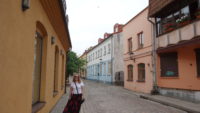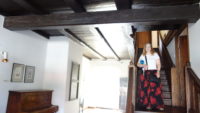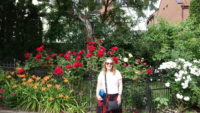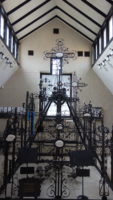 Klaipeda and this region is collectively called Lithuania Minor. It has a complicated history. If Lithuania’s history is tough for an American to figure out, then Lithuania Minor’s history goes to eleven. Complicated doesn’t even begin to cover it.
Klaipeda and this region is collectively called Lithuania Minor. It has a complicated history. If Lithuania’s history is tough for an American to figure out, then Lithuania Minor’s history goes to eleven. Complicated doesn’t even begin to cover it.
Mer hit a triple today – three museums in one day, and all for one ridiculously low price. We’ve been joking how every Lithuanian museum costs five euros to get into (about $5.50). My best guess is that museums here are subsidized somehow, because there is no way they can cover costs for five bucks for a ticket. Today, Mer noticed at the first museum that there was a combo ticket for the three museums she was possibly interested in seeing, and the cost for all three together was six euros. For three museums. My sight-loving and thrifty wife was thrilled.
We started the day at the Lithuania Minor History Museum. It focuses on this region – the western part of Lithuania, near the sea. It’s a small area, but has seen many changes. The museum did the museum thing and started in the stone age and worked up to about 1200, but it did so in four large cases instead of four rooms, as we had seen in previous museums. Since it focused more on the Klaipeda area, it focused more on the several tribes here, and that meant they could speak more in depth about customs, especially burial. Graves are one of the major sources of information on the people of the area, and so we got to see a mock-up of what a wealthy woman would have worn based on what they found in her grave. That was interesting; the most unusual thing was the two-pound chain she wore, which had buckles and multiple chains of metal. Iron-age bling was a thing.
 As far as I understand and remember, this area was home to a bunch of tribes. They had some dealings with the Vikings, sometimes fighting them and sometimes living peacefully with them. Then European crusaders came along to fight with the pagans (a loose justification for a land grab). One of the groups built a castle here at the mouth of the river and called it Memel. Then, somehow, the Teutonic Order took over and fought the locals for 150 years. Sometimes the town around the castle was burned to the ground, and once or twice the castle was burned. Then the Teutonic Order ticked off too many people, and Lithuania and Poland joined forces and beat them back in many places. I think the Order signed a peace treaty here, but that’s some of the muddy area for me. The Reformation came along, and the head of the Order converted the Order and founded a Duchy instead. Happily, he was the first duke, so that worked out.
As far as I understand and remember, this area was home to a bunch of tribes. They had some dealings with the Vikings, sometimes fighting them and sometimes living peacefully with them. Then European crusaders came along to fight with the pagans (a loose justification for a land grab). One of the groups built a castle here at the mouth of the river and called it Memel. Then, somehow, the Teutonic Order took over and fought the locals for 150 years. Sometimes the town around the castle was burned to the ground, and once or twice the castle was burned. Then the Teutonic Order ticked off too many people, and Lithuania and Poland joined forces and beat them back in many places. I think the Order signed a peace treaty here, but that’s some of the muddy area for me. The Reformation came along, and the head of the Order converted the Order and founded a Duchy instead. Happily, he was the first duke, so that worked out.
The bottom line of all of this is that Lithuania Minor had a mixture of Lithuanians and Germans. That became tricky, as both Lithuania and Germany laid claim to the land, as well as Poland and Russia by proximity. When Russia controlled the area, for much of the 1800s, they tried to ban books in the Lithuanian language and tried to make the area more Russian. It didn’t work, as a healthy book-and-newspaper-smuggling business sprang up in adjacent East Prussia (which was part of Germany). The Russians gave up in the late 1800s.
 Klaipeda was right on the front line in World War I as Germany forced Russia back. Once the war was over, Lithuania Minor was taken from Germany as part of the Treaty of Versailles. It was run by the victors, and mostly by the French. They eventually gave the territory over to Lithuania, which made it an autonomous region within the country. Then in 1939, Germany forced Lithuania to give it back to them, claiming it was German.
Klaipeda was right on the front line in World War I as Germany forced Russia back. Once the war was over, Lithuania Minor was taken from Germany as part of the Treaty of Versailles. It was run by the victors, and mostly by the French. They eventually gave the territory over to Lithuania, which made it an autonomous region within the country. Then in 1939, Germany forced Lithuania to give it back to them, claiming it was German.
So World War II was terrible for this region. Men were drafted to fight for Germany, and again the front lines ran through here as Germany and Russia fought over the place. By the time the war had ended, a staggering ninety-one percent of the local population had either left or was evacuated ahead of the Russians or was dead. Ninety-six percent of the Jewish population of the area died. The town was a wreck. It’s hard to imagine that this vibrant place has only really been around for about eighty years.
The museum had other exhibits, including on one money in the region. With so many nations coming through, there have been many currencies, even from just 1900. There was a book collection and objects from twentieth-century life and a section devoted to folk living in the 1800s to the mid 1900s. The final room had a collection of decorative pins and a room set up as if it were in the 1970s. Quirky museum.
The second museum was the Castle Museum. There is no castle at the Castle Museum – the castle was torn down in the late nineteenth and twentieth centuries, but the earthworks from around the castle are there, and it looks as if they have construction projects going on to rebuild a visitor center in the form of one of the towers. There is a top-notch museum in the middle of the old castle complex, focusing on archaeological finds from the castle and the Old Town.
 Much of what was covered in the Castle Museum overlapped with the info from the earlier history museum, but with more artifacts. We had very good audioguides, and there was a film that introduced us to members of the town from a few hundred years ago. All of the displays were of items dug up here, so that was interesting. The items were, not surprisingly, made up largely of military items and fishing items, as well as broken housewares and some jewelry.
Much of what was covered in the Castle Museum overlapped with the info from the earlier history museum, but with more artifacts. We had very good audioguides, and there was a film that introduced us to members of the town from a few hundred years ago. All of the displays were of items dug up here, so that was interesting. The items were, not surprisingly, made up largely of military items and fishing items, as well as broken housewares and some jewelry.
Outside the archaeology museum were two tunnels to explore – one of brick that displayed photos from the early twentieth century, but the placards were all in Lithuanian only, so we made quick work of that tunnel. The other was where ammunition had been stored, and that was dedicated to the years 1939-1945, with dozens of interactive screens and maps. There were photos and a German and a Russian military uniform, as well as films. I was a little sad that we were rushed for time – it would have been easy to spend an hour or more in the bunker. The last display was on victims of the war, told in photographs. One of the saddest ones was a newspaper article of lost persons showing three little girls looking for parents or relatives. In the center of the room was a long table covered in sand. If you brushed the sand away from the glass it was resting on, it revealed photos of people or personal items. It was moving.
 It was about 5:00, and the last museum closed at 6:00, so we left the castle complex and walked over to the Blacksmith’s Museum. The museum was made up of ironwork all from one master blacksmith from the early twentieth century. I like ironwork, so this was my cup of tea. The museum was very small – a medium-sized room downstairs, a large room upstairs, and an outdoor courtyard. The work was excellent, especially the crosses done for churches and graves, but the highlight of the museum was the woman working there. She took us around and showed us everything herself, which was immensely kind. Especially since she spoke almost no English (maybe a dozen words, all told). Though speaking to us in Lithuanian, she used gestures and inflection to try to help us understand, and she kept that up for the twenty-minute tour. It was very touching. She really wanted to help us, which is something we have found from all of our museum visits – the docents try hard to make sure you see things by pointing the way to the next exhibit and going with you to make sure the lights are on. Great people.
It was about 5:00, and the last museum closed at 6:00, so we left the castle complex and walked over to the Blacksmith’s Museum. The museum was made up of ironwork all from one master blacksmith from the early twentieth century. I like ironwork, so this was my cup of tea. The museum was very small – a medium-sized room downstairs, a large room upstairs, and an outdoor courtyard. The work was excellent, especially the crosses done for churches and graves, but the highlight of the museum was the woman working there. She took us around and showed us everything herself, which was immensely kind. Especially since she spoke almost no English (maybe a dozen words, all told). Though speaking to us in Lithuanian, she used gestures and inflection to try to help us understand, and she kept that up for the twenty-minute tour. It was very touching. She really wanted to help us, which is something we have found from all of our museum visits – the docents try hard to make sure you see things by pointing the way to the next exhibit and going with you to make sure the lights are on. Great people.
Having exhausted our museum tickets and ourselves, we went to the main square in the Old Town for supper. The music festival was still going on, and we enjoyed about an hour of swing music and the swing-end of jazz while we ate. That was a good way to relax after being on our feet for much of the day.
Tomorrow we head over to the Curonian Spit, a miles-long sandbar that separates the Curonian lagoon from the Baltic Sea. We’ll have a short ferry ride to get there with the car, and here’s hoping that won’t be too complicated.
Hmmm. Castle, my a$$.
We used your Versailles comment about the “sleepy fishing village” earlier. It’s useful.